Start with our video overview:
Capua is a significant site along Via Appia with an interesting history and is nearly as old as Rome. It is known for its colossal amphitheater and its role in the slave revolt led by Spartacus. Via Appia still runs through the modern day city, supporting traffic as the SS7 road.
Capua (or Capeva), meaning ‘city of marshes,’ was founded by the Etruscans around 600 BCE during the peak of their power, but was taken over by the Samnites in 424 BCE and aligned with Rome in 343 BCE seeking protection against its conquerors. In Rome, Via Appia passed through the Servian Walls via a gate named Porta Capena, indicating its direction towards Capua.
Its ties to Rome established Capua as a prominent ally: at the outbreak of the Second Punic War, Capua provided the highest number of soldiers. After a significant defeat that demonstrated Hannibal’s power, the general arrived in the city and made it his winter residence. When Rome emerged victorious from the war, it punished Capua by executing its magistrates and seizing its land as public property of Rome. Nonetheless, the city continued to flourish as a key producer of spelt and bronze. It had such a reputation for luxury that Livy blamed the failure of Hannibal’s army on being ‘worn out’ from indulging in wine and women. This did not impede imperial interest in the city; Julius Caesar founded a colony of 20,000 Roman citizens, later increased by Mark Anthony and Augustus.
The remains of a small amphitheater – potentially the first in Italy – were found in Capua. Gladiatorial games are believed to have been developed here, the city where Spartacus, an enslaved gladiator, would have fought. In 73 BCE, Spartacus and fellow enslaved gladiators broke out of the ludus (gladiatorial school) in Capua before fleeing to Mount Vesuvius. Others, including veterans from the recent Social War, were inspired to join their forces which grew in number to 70,000. For two years, Rome was alarmed by its inability to quell the uprising, taking the extreme measure of executing its own soldiers. In 71 BCE, the forces were finally defeated; Spartacus reportedly died in the battle, and 6,000 captured survivors were crucified along Via Appia all the way from Rome to Capua.
An imperial-era amphitheater which was second in size only to the Colosseum replaced the theater of Spartacus’ day, demonstrating the continued importance of Capua. The structure is well-preserved, especially its hypogeum, because unlike the Colosseum in Rome, it was not modified for medieval reuse. The Third Servile War is considered a significant factor in the events which gradually led to the transition from the Roman Republic to the Empire. In addition to indicating architectural and cultural practices, the remains of both amphitheaters attest to watershed moments in Roman history which took place along Via Appia.
References
- E. Smitha, “Demise of the Roman Republic”, (1998).
- Bradley, “Slavery and Rebellion in the Roman World”, (Indiana 1989).
- Livy, “Ab Urbe Condita”, 23.45.
This content is brought to you by The American Institute for Roman Culture, a 501(C)3 US Non-Profit Organization.
Please support our mission to aid learning and understanding of ancient Rome through free-to-access content by donating today.
Cite This Page
Cite this page as: Darius Arya, The American Institute for Roman Culture, “Via Appia: Episode V, Capua – Where Spartacus Trained and Revolted” Ancient Rome Live. Last modified 01/19/2023. https://ancientromelive.org/via-appia-episode-v-capua-where-spartacus-trained-and-revolted/
License
Created by The American Institute of Roman Culture, published on 02/04/2023 under the following license: Creative Commons: Attribution-NonCommercial-ShareAlike. This license lets others remix, tweak, and build upon this content non-commercially, as long as they credit the author and license their new creations under the identical terms. Please note that content linked from this page may have different licensing terms.



